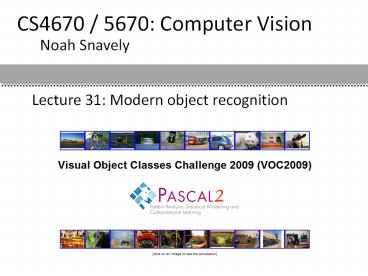Lecture 31: Modern object recognition - PowerPoint PPT Presentation
Title:
Lecture 31: Modern object recognition
Description:
Noah Snavely Lecture 31: Modern object recognition CS4670 / 5670: Computer Vision * CS 376 Lecture 22 CS 376 Lecture 22 * CS 376 Lecture 22 Announcements Project 4 ... – PowerPoint PPT presentation
Number of Views:170
Avg rating:3.0/5.0
Title: Lecture 31: Modern object recognition
1
Lecture 31 Modern object recognition
CS4670 / 5670 Computer Vision
Noah Snavely
2
Announcements
- Project 4 due today
- Demos Monday
3
Object detection where are we?
Credit Flickr user neilalderney123
- Incredible progress in the last ten years
- Better features, better models, better learning
methods, better datasets - Combination of science and hacks
4
Vision Contests
- PASCAL VOC Challenge
- 20 categories
- Annual classification, detection, segmentation,
challenges
5
Machine learning for object detection
- What features do we use?
- intensity, color, gradient information,
- Which machine learning methods?
- generative vs. discriminative
- k-nearest neighbors, boosting, SVMs,
- What hacks do we need to get things working?
6
Histogram of Oriented Gradients (HoG)
HoGify
Dalal and Triggs, CVPR 2005
7
Histogram of Oriented Gradients (HoG)
8
Histogram of Oriented Gradients (HoG)
- Like SIFT (Scale Invariant Feature Transform),
but - Sampled on a dense, regular grid
- Gradients are contrast normalized in overlapping
blocks
Dalal and Triggs, CVPR 2005
9
Histogram of Oriented Gradients (HoG)
- First used for application of person detection
Dalal and Triggs, CVPR 2005 - Cited since in thousands of computer vision papers
10
Linear classifiers
- Find linear function to separate positive and
negative examples
Which lineis best?
slide credit Kristin Grauman
11
Support Vector Machines (SVMs)
- Discriminative classifier based on optimal
separating line (for 2D case) - Maximize the margin between the positive and
negative training examples
slide credit Kristin Grauman
12
Support vector machines
- Want line that maximizes the margin.
wxb1
wxb0
wxb-1
For support, vectors,
Support vectors
Margin
C. Burges, A Tutorial on Support Vector Machines
for Pattern Recognition, Data Mining and
Knowledge Discovery, 1998
slide credit Kristin Grauman
13
Person detection, ca. 2005
- Represent each example with a single, fixed HoG
template - Learn a single linear SVM as a detector
Code available http//pascal.inrialpes.fr/soft/ol
t/
14
Positive and negative examples
thousands more
millions more
15
HoG templates for person detection
16
Person detection with HoG linear SVM
Dalal and Triggs, CVPR 2005
17
Are we done?
18
Are we done?
- Single, rigid template usually not enough to
represent a category - Many objects (e.g. humans) are articulated, or
have parts that can vary in configuration - Many object categories look very different from
different viewpoints, or from instance to
instance
19
Difficulty of representing positive instances
- Discriminative methods have proven very powerful
- But linear SVM on HoG templates not sufficient?
- Alternatives
- Parts-based models Felzenszwalb et al. CVPR
2008 - Latent SVMs Felzenszwalb et al. CVPR 2008
- Todays paper Exemplar-SVMs, Malisiewicz, et al.
ICCV 2011
20
Parts-based models
Felzenszwalb, et al., Discriminatively Trained
Deformable Part Models, http//people.cs.uchicago.
edu/pff/latent/
21
Latent SVMs
- Rather than training a single linear SVM
separating positive examples - cluster positive examples into components and
train a classifier for each (using all negative
examples)
22
Two-component bicycle model
side component
frontal component
23
Six-component car model
side view
frontal view
root filters (coarse)
part filters (fine)
deformation models
24
Six-component person model
25
- Twenty object categories (aeroplane to
TV/monitor) - Three challenges
- Classification challenge (is there an X in this
image?) - Detection challenge (draw a box around every X)
- Segmentation challenge































